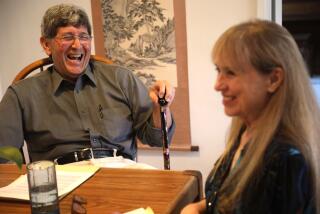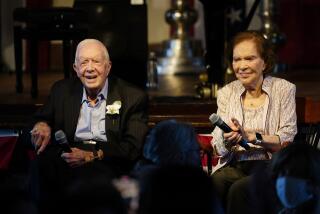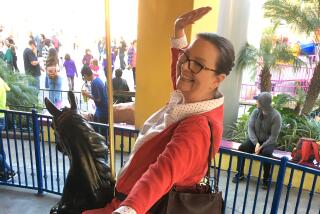Not ready to die, but prepared
The cancer that started 11 years ago has now ravaged the body of Freddie Ramos. It attacked a kidney first, then a lung, and the 57-year-old family man knows that death waits in the near distance.
He’s not ready to go, he says, but he’s prepared.
“Living in fear of death is no way to live,” Ramos told me in the living room of the Los Feliz home he shares with his wife, Robin, and their daughters Bailey and Maya.
A Santana concert poster hangs on the wall, Hollywood Bowl, 2002, and a Diego Rivera art poster is nearby. Ramos, who once directed a program to reintegrate parolees into the community, now holds forth from a comfy sofa, a thin man with a long black goatee, and you can see in his dark eyes that there’s been a reckoning. Ramos has found that the only victory left to him was in giving up the fight, and savoring the time he has left.
He and Bailey, 18, make breakfast together in the morning. Maya, 16, plays classical piano and fills the house with music.
“I am loving this time,” said Robin, a math teacher.
It’s an odd thing to hear her say, given the gravity of her husband’s condition, and it’s even stranger to see Freddie Ramos nodding in full agreement. But when Ramos’ heart failed in September, they thought he was gone, so this feels like overtime. And they’ve gracefully transitioned from fighting death to enjoying what is left of life.
Not that the transition was easy. There were difficult, frank conversations and lots of prayers before a sense of calm settled in and Ramos knew he was done with chemotherapy.
“It might give me three more months,” Ramos said, but the side effects would be unpleasant, and he was finished with such compromises.
A Kaiser member, Ramos was offered a chance to receive hospice care with a focus on palliative measures. Those are ominous-sounding words to a lot of terminally ill patients, and Ramos was no exception. The picture that popped into his head was of him dying in some kind of nursing facility with the hospice team at his side.
No, he was told. He could go home and be with his family. A doctor, nurse, social worker and chaplain would make house calls, care for Ramos and educate and support his family. If there were emergencies, he could still go to the hospital.
The fact that Ramos has rallied a bit since leaving the hospital in September does not surprise his doctor.
“All of our patients prefer to be home,” said Dr. Peter Khang, chief of geriatrics and palliative medicine. He noted that in addition to familiar surroundings, home cooking and the love of family, this kind of care means fewer stressful, exhausting trips to the clinic or hospital.
Susan Enguidanos, an assistant professor of gerontology at USC, specializes in end-of-life care and has helped monitor Kaiser’s in-home treatment programs. She said a study of Kaiser’s in-home palliative program about 10 years ago showed a 45% reduction in patient costs due to the avoidance of emergency room and hospital visits, and more important, there was also a sharp increase in patient satisfaction. Other such studies, she said, have shown that 71% of palliative care patients die at home, as most people say they would prefer to do, as opposed to only 50% of those not in such programs.
The national implications are enormous, given that a large portion of the debt crisis in the United States is due to rising healthcare costs. Enguidanos said roughly 27% to 30% of total Medicare costs go to the 10% of patients who are dying, and she estimated that by placing greater emphasis on in-home care, Medicare could save 25% of what it spends on patients in the last year of life.
So why isn’t this front and center in a presidential campaign season? Because many people don’t understand that hospice and palliative care are about both living and dying with dignity, and because any civil discussion about end-of-life policy is more difficult since Sarah Palin uttered the words “death panels.” Enguidanos and the medical staff at Kaiser — including Drs. Richard Brumley and Nancy Gibbs — told me they hope more research and education will convince the public and politicians that lower costs and greater patient satisfaction are both possible with greater emphasis on in-home care.
In Los Feliz, Ramos answered questions from Khang about his strength, appetite and daily activities while his nurse, Susan Romo, showed me a form Ramos had signed. It’s called a “physician’s order for life-saving treatment.” Ramos had checked the “do not resuscitate” box. He wants no feeding tube, either, and no ventilator.
“I do not want to be put on life support,” he said.
His wife was spooked about all of this at first, until they talked through their fears together and the hospice staff answered questions big and small.
“I didn’t know how to have him die in the house,” said Robin, but the hospice team explained the process, adding that she could close his eyes if she wishes.
“Freddie’s not afraid of death,” said Robin, who called him a very spiritual man. Even when he’s watering the garden and wagging the hose back and forth, she said, he’s praying.
They go to lunch together, and shopping too, and they make a point of having dinner with the girls.
Freddie Ramos says he considers his illness an ally in the sense that it taught him each day is a blessing. And now he’s living as well as can be expected, not yet ready to go, but prepared.
More to Read
Sign up for Essential California
The most important California stories and recommendations in your inbox every morning.
You may occasionally receive promotional content from the Los Angeles Times.











